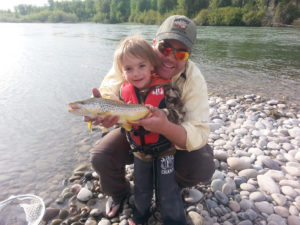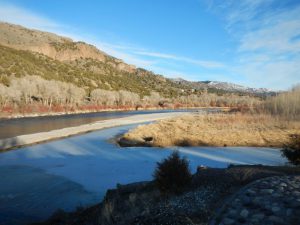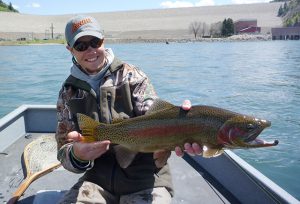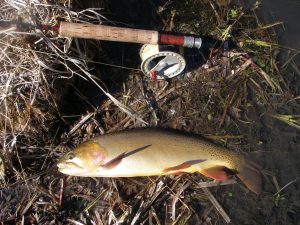South Fork 5-22-18
FYI: Flow out of Palisades Reservoir was upped from 16000 cfs to 18000 cfs yesterday. So the days of equilibrium conditions on the river are gone for a while. Palisades Reservoir is at about 60% of capacity.
FYI: Flow out of Palisades Reservoir was upped from 16000 cfs to 18000 cfs yesterday. So the days of equilibrium conditions on the river are gone for a while. Palisades Reservoir is at about 60% of capacity.

It’s not all bad news for the South Fork, because nymph fishing seems to be improving. Currently Palisades Reservoir is at 60% of capacity. Water coming out is cold, but clearing, and flow out of Palisades Dam has been nearly constant at 16000 cfs for about two weeks. So stable conditions are present. Big rubber legs and stonefly nymph patterns work as do small bead head nymphs in riffles.

Flow out of Palisades dam has been constant at just under 16000 cfs for about a week. That’s a few thousand cfs higher than average and may not remain at that level, particularly if our weather warms. Palisades Reservoir is filling and is near 60% full. Most effective fishing currently is through boating to present rubber leg patterns deep and the same for streamers under low light conditions.

Looks like the South Fork is on its way to reasonable fly-fishing conditions, but has a way to go. On May 1st flow from Palisades Dam was dropped to 13900 cfs (now 15400 cfs at Heise, 11200 cfs at Lorenzo) and remains there this day. The reservoir is currently about 47% of capacity and slowly filling. Warming weather and abundant remaining snow could speed up the filling rate. So for now stock up on well-weighted streamer, San Juan worm, and rubber leg patterns because better fly-fishing days on the river are soon to come.
Yesterday flow out of Palisades Dam was increased to 18000 cfs. That flow makes for difficult near-term fishing. Over the last month the Palisades Dam flow graph looks like a step function, and for good reason. There is more than normal snow pack in the upper Snake River drainage. Thus the Bureau of Reclamation placed a public announcement on April 3rd giving their Snake River water management strategy. Here is an excerpt from it that impacts the South Fork reach and the main stem Snake River to just below American Falls Dam. Note Reclamation’s estimate of 114% of the recent decade average. That’s the basis for their management strategy.
Reclamation’s April through July volume runoff forecast for Heise is 3700 KAF, which is 114% of the 1981-2010 average. To begin advancing on updated flood control targets for Jackson Lake Dam and Palisades Dam the following changes have or will be made this week.
· Jackson Lake Dam discharge will be increased Thursday (4/5) at 10 am from the current 630 cfs up to between 1,000 cfs and 1,500 cfs.
· Palisades Dam discharge will be increased Thursday (4/5) evening into Friday (4/6) morning to go from the current 10,000 cfs up to between 14,500 cfs and 16,000 cfs by Friday morning.
· American Falls Dam discharges were increased today from 11,000 cfs to 13,000 cfs. Another increase will occur Wednesday (4/4) morning at 10 am to go from 13,000 cfs to 15,000 cfs.
The intent with respect to Palisades Reservoir is to decrease its capacity to around 50% ( Currently at about 70%) in order to contain expected run off. More increases in flow out of these three dams are possible, with weather being a factor in determining flow management. For additional information and resources, please visit Reclamation’s website at: https://www.usbr.gov/pn/hydromet/uppersnake/ .

Palisades Reservoir seems to be filling. Volume of water there was 95% capacity a few days ago, now it is 97% capacity. Look for flows into the South Fork to remain about where they are now ( about 4200 cfs) with future increases out of Palisades Reservoir possible. Although walk-in-wade fishing will be a bit tougher than in past winters, fish will be the big winners of these flows if they last through the winter. Whether or not we have high water conditions during spring and summer of 2018 depends on snowfall amounts this coming winter. Until springtime midge hatches will provide top water fishing, while presenting streamer patterns and nymph patterns ranging from small bead heads to larger rubber leg types will result in the best techniques for sub-surface fishing.

Flow out of Palisades Dam was raised to 3130 cfs last Thursday ( upping flow at Heise to almost 3600 cfs). With Palisades Reservoir about 95% full and at least normal snowfall expected this winter in the Snake River drainage, look for flows below Palisades Dam to be higher this winter than in recent years. A forecast for mild weather for this week should result in good BWO activity. Midge activity remains consistently good, and presenting streamer patterns under low light conditions is a sure way to find action from migrating browns and the rainbows following them this time of year.
As Flows on the south fork drop to around 2,500 cfs out of Palisades dam, we are starting to see what the wade options are going to look like during the first part of the fall and winter months. Talk is that the river flows will be re-evaluated after the 1st of December, in which case will most likely be increased. This can mean some good news for the boat fisherman, as float will take less time to complete, and you will be able to cover more water. For the wade fisherman these changes will have more effect than in winters past where we are use to seeing the flow around 1,200.
As for the current conditions, the South Fork streamer fishing has been pretty good on cloudy days, and even on some random sunny days as well.. Color is the name of the game her, so bring your sparkle, white, yellow, tans, and olives. Some days the darker colors really do well, but overall this river seems to respond best to brighter, and flashier patterns.
Dry fly fishing is good, but as per usual, the cloudy days reign supreme. Fish size 18-20 BWO patterns, and 18-20 midge patterns. Back eddies are a great option for finding fish feeding on the surface.
Try fishing nymphs from the boat set at 5-6 feet for floating. I generally run much deeper when standing on a riffle, and in most cases would recommend the same. Use a small rubberlegs, a san juan work, or a big caddis pattern, trailed by a small beadhead mayfly nymph in the size 14-18 range. If in doubt, a red Zebra midge will usually get the job done as a trailer fly.
As for fishing on the main (Idaho Falls to American Falls), the streamer is the main game here, as browns are in their pre spawn, and are on the streamer bite pretty well. Patterns I usually do best on are Tan or natural peanut envys, and sex dungeons, but like anywhere changing pattern and color can sometimes make the difference.
American Falls is running at 2,100 cfs, and the wade fishing is much tougher than usual. The water had changed colors the last time I was there a couple days ago, leaving the visibility at roughly 2′ tops. I would recommend that anybody planning on wading there to bring a wading staff so they can poke around before they step. Flies that are fishing well is pretty much any beadhead nymph in a size 12-18, and dead drifted streamer patterns. If your into dry fly fishing, you can fish blue winged olives and find success.
Flows on the South Fork have been reduced to 2,573 cfs coming out of the dam. These are likely to be the winter flows, check back with us for more updates.

Flow out of Palisades Reservoir has been nearly constant for most of the month, that is between 3500 and 4000 cfs. Constant flow is a main reason for continued good fishing. An example is that riffle fishing this fall has been at its best for the entire season. Great BWO activity with some from mahogany duns with resulting great responses from the trout population in riffles has been the norm for several weeks. As we move into November streamer fishing will move from currently good to excellent. However, look for further reductions in flow out of the reservoir in the upcoming weeks as water storage for next year’s irrigation continues.
